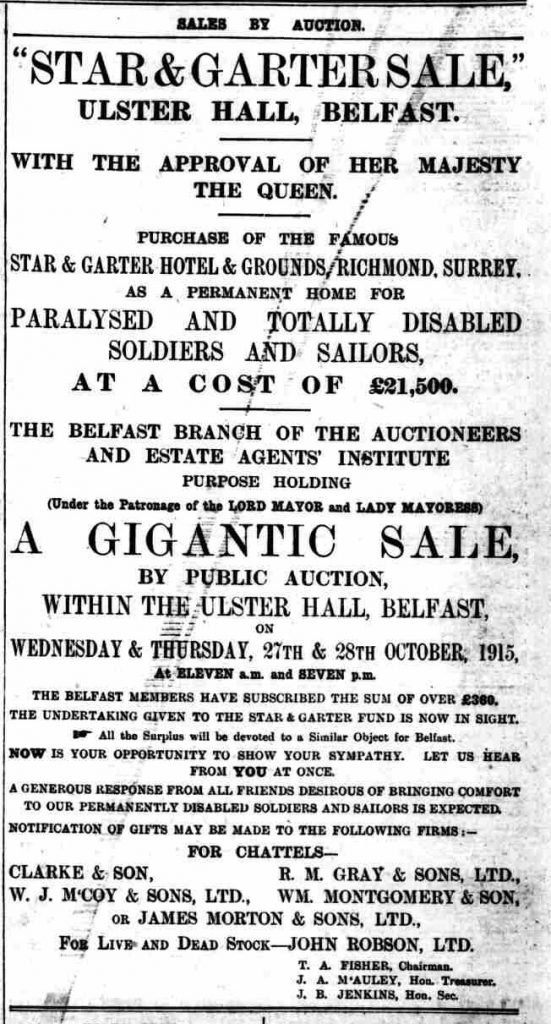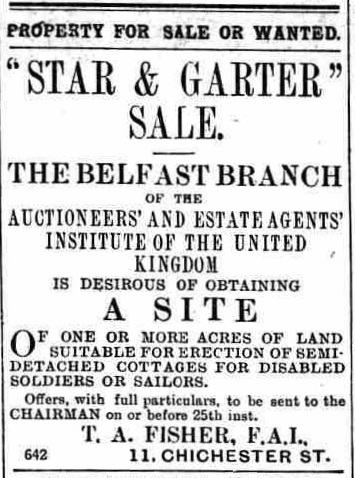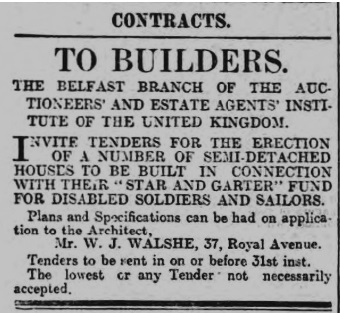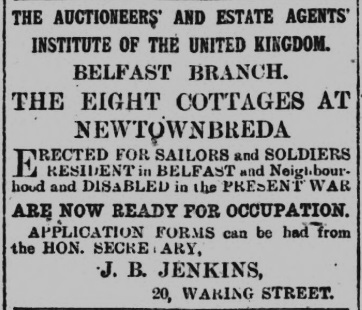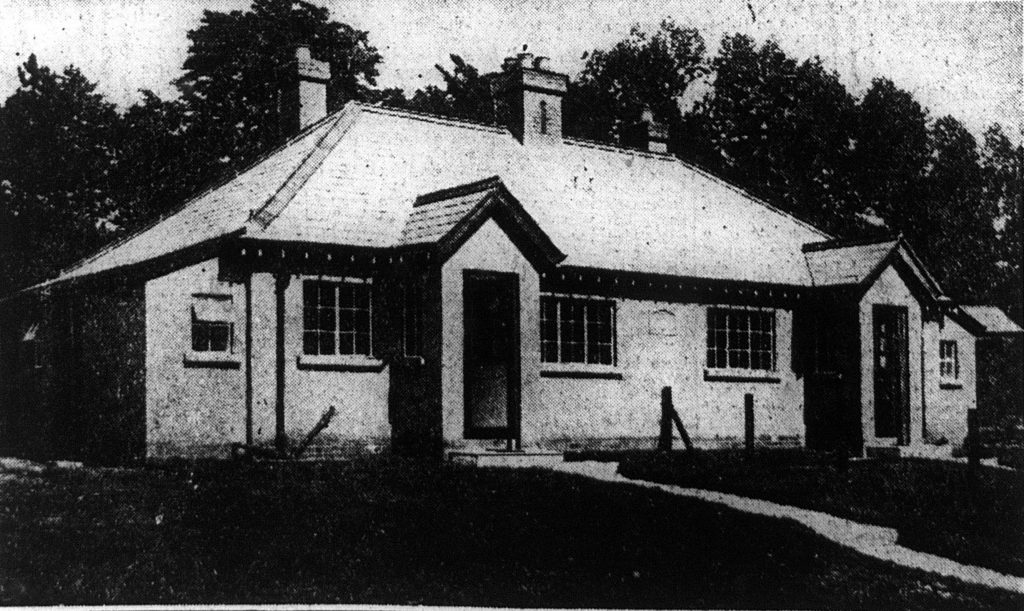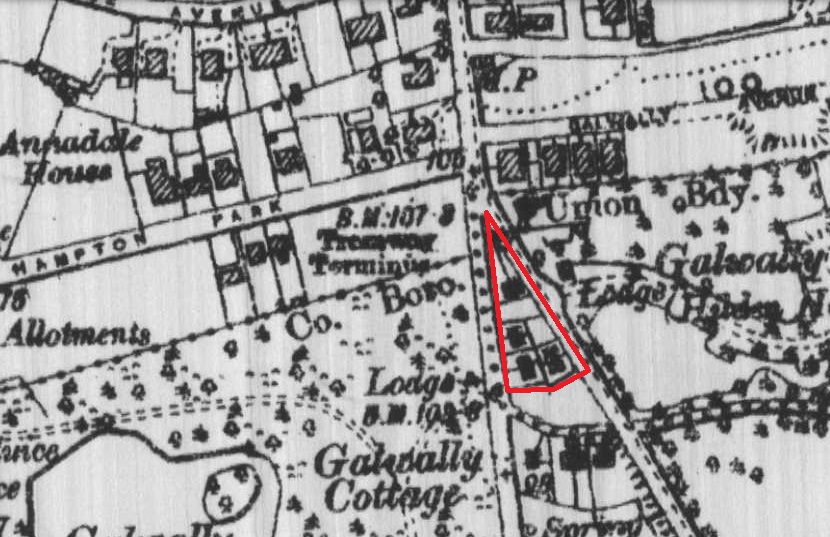Gallaher and Company, Belfast

The tablet commemorating fatalities and those who served from the firm was unveiled on 2nd June 1948 by Captain John Hugo Russell CBE, 3rd Baron Ampthill. John Russell, who had served with the Royal Navy in both world wars, was the Production Director at the Gallaher factory and is the first name in the “Served” section. Although there is a civilian air raid fatality commemorated on the memorial tablet, there should perhaps be two fatalities commemorated. Benjamin Kennedy of 33 Earl Street, adjacent to the Gallaher factory, was recorded as being a tobacco worker when he died at York Street on 16th April 1941, aged 19, and was buried in Carnmoney Main Cemetery on 20th April 1941.
The ten fatalities are listed by service:
Royal Navy (2), Army (4), Royal Air Force (3), Air Raid Fatality (1).
The names of the 335 employees who served and survived are also recorded by service:
Royal Navy (36), Army (145), Royal Air Force (45), Royal Marines (3), Merchant Navy (7), Women’s Royal Naval Service (14), Auxiliary Territorial Service (7), Women’s Auxiliary Air Force (44), Queen Alexandra’s Imperial Military Nursing Service (1), Voluntary Aid Detachment (2), Women’s Voluntary Service (2), Nursing (20), National Fire Service (6).


Signalman Wallace Boyd McCappin (P/UD/X 1362, Royal Naval Volunteer Reserve, HMS Esk)
Whilst laying mines off the Dutch coast, HMS Esk struck a German mine, and a subsequent explosion amidships caused the ship to break in two. Signalman McCappin was 22 years old and is commemorated on the Portsmouth Naval Memorial. He is also commemorated on a family memorial in Carnmoney Cemetery. He was born on 3rd January 1918 at Upper Mervue Street to Robert McCappin, a riveter, and Jane McCappin (nee McClean).
Petty Officer Alexander McIlwaine (D/M 35507, Royal Navy, HMS Caroline)
Alexander McIlwaine died at 26 Jellicoe Avenue on 25th June 1946, aged 54, and is buried in Carnmoney Cemetery East. He was living in one of fifty houses built by the Irish Sailors and Soldiers Land Trust at Jellicoe Avenue for veterans of the Great War. Alexander McIlwaine was born on 15th June 1892 at Dunfane near Kirkinriola to Robert McIlwaine, a baker, and Jane McIlwaine (nee Anderson). He was a flax bundler when he enlisted with the Royal Navy (Number J.5236) as a “Boy” on 4th August 1909 and was established as an Ordinary Seaman (Number M.35507) on 15th June 1910.

He attained the rank of Regulating Petty Officer and served on HMS Bellerophon at the Battle of Jutland. The last ship on which he served was King George V and he was invalided from the service due to pulmonary tuberculosis on 2nd September 1925, having served for over 15 years. His service in the Great War is recognised on the memorial tablet for First Ballymena Presbyterian Church. Alexander married Elizabeth Dundas on 12th February 1925 at First Ballymena Presbyterian Church. He returned to naval service on 20th April 1940, serving on HMS Caroline until 6th January 1943.
Alexander McIlwaine died at his Jellicoe Avenue home on 25th June 1946, aged 54. He was a member of the Postmen Ex-Servicemen’s Association, the Three Brothers Masonic Lodge 775 and Royal Arch Chapter 755 in Ballymena. Alexander left effects totalling £810 (approximately £27,900 in current terms) to his widow, Elizabeth. Elizabeth McIlwaine was living at Jellicoe Avenue when she died at Belfast City Hospital on 17th April 1962, aged 63. Alexander and Elizabeth McIlwaine are buried in Carnmoney Cemetery East. Also buried in the plot is their son, Ernest, who was living at Jellicoe Avenue when he died on 11th September 1970.

Gunner Leonard Edgar (1475599, 23 Battery, 8 Heavy Anti-Aircraft Regiment, Royal Artillery)
Leonard Edgar was Killed in Action on 23rd May 1940, aged 24, and is buried in Wimereux Communal Cemetery in France. His death was confirmed in September 1942, and he is commemorated on a family memorial in Belfast City Cemetery.
Leonard Edgar was born on 24th March 1916 at 58 Brookmount Street to Leonard Edgar, a joiner, and Sarah Ann Edgar (nee McIlroy). He married Norah Goward on 25th August 1937 at St Matthew’s Church of Ireland, Woodvale, and they were living at 71 Brookmount Street in 1939. He was survived by Norah and their two-year-old daughter, Leonora.
Serjeant Thomas Bullock (3593582, 94 Light Anti-Aircraft Regiment, Royal Artillery)
Thomas Bullock died on 8th April 1945, aged 38, and is buried in Sage War Cemetery in Germany. Thomas Bullock was born on 28th May 1906 at Teutonic Street to William Bullock and Charlotte Bullock (nee Mahon). Thomas Bullock married Edna May Beattie on 22nd August 1936 at Great Victoria Street Presbyterian Church. Edna and their infant son were living at 32 Britannic Street when Thomas died.
Gunner Albert Kinnon (1459544, 8th (Belfast) Heavy Artillery Regiment, Royal Artillery
Albert Kinnon was Killed in Action on 8th February 1944, aged 37, during the Battle of Admin Box. He is buried in Taukkyan War Cemetery in Myanmar/Burma and is commemorated on a family memorial in Carnmoney Cemetery East. Albert Kinnon was born on 14th September 1906 at Shannon Street to Thomas Kinnon and Georgina Kinnon (nee Brown) and the family lived at 81 Unity Street in 1911. Albert married Agnes Gould on 9th July 1928 at St Michael’s Church of Ireland, Craven Street, and they lived at 77 York Park, Belfast.

Captain James Charles Skelly (265920, 82 Assault Squadron, Royal Engineers)
James Charles Skelly was Killed in Action on 1st November 1944, aged 25, when his tracked landing vehicle was hit whilst coming ashore at Westkappele during the Battle of the Scheldt. He is commemorated on the Groesbeek Memorial in The Netherlands. James Charles Skelly was born on 1st March 1919 at 119 Limestone Road to Samuel Skelly, a window cleaner, and Louisa Skelly (nee Whyte), who were living at 154 Limestone Road when their son died.

Flight Sergeant Thomas Colquhoun Edmonds Berkeley (754377, 85 Squadron, Royal Air Force Volunteer Reserve)
Thomas Berkeley Died on 14th June 1941, aged 24, when his Boston Havoc aircraft failed to return from an operational flight, and he is commemorated on the Runnymede Memorial in England. He is also commemorated on is commemorated locally on Cookstown War Memorial and on the Roll of Honour for Molesworth Street Presbyterian Church.
Thomas Colqhoun Edmonds Berkeley was born on 2nd October 1916 to James Lowry Berkeley and Eleanor Berkeley (nee Paden) of Poplar Hill, Tullyhogue, Tyrone. One of his brothers, Lowry Berkeley, a manager at the Gallaher factory, was in the Ulster Home Guard whilst two sisters, Miss Eleanor Veronica Berkeley and Miss Gladys Berkeley, served with the Women’s Royal Naval Service.

Sergeant Herbert Reginald Megarry (745111, No. 6 Service Flying Training School, Royal Air Force Volunteer Reserve)
Herbert Reginald Megarry was undergoing pilot training when he died in a flying accident in Oxfordshire on 18th May 1940, aged 20, and is buried in Bangor Cemetery. His Harvard aircraft spun to the ground after the engine stalled following a steep turn. He is also commemorated on the Bangor and District War Memorial and at St. Comgall’s Church of Ireland in Bangor.
Herbert Reginald Megarry was born on 4th May 1920 at Ravenhill Avenue to James Herbert Megarry, a warehouseman, and Harriett Megarry (nee Bailie). Herbert worked in the Engineering Department at the Gallagher factory before joining the Royal Air Force Volunteer Reserve.

Sergeant George Albert McGarvey (969452, 455 (Royal Australian Air Force) Squadron, Royal Air Force Volunteer Reserve)
George Albert McGarvey died on 7th November 1941, aged 20, and is buried in Heverlee War Cemetery in Belgium. Sergeant McGarvey was the Wireless Operator and Air Gunner on a Hampden aircraft from RAF Swinderby failed to return from an armed reconnaissance flight towards Cologne. The three other members of the crew also died. George Albert McGarvey was born on 16th December 1920 in Dublin to George Edward McGarvey and Ellen McGarvey (nee Cossar). His father had served with the Royal Engineers and was a Second Lieutenant in the Royal Irish Rifles at Victoria Barracks when he married Ellen Cossar on 18th April 1918 at the United Free Church of Scotland in Lower Abbey Street, Dublin.
William John Lancaster
William John Lancaster was a son of William Raynard Lancaster and Eliza Jane Lancaster (nee Duncan) who had married in Belfast in 1909. William Reynard Lancaster served with the Royal Sussex Regiment from November 1893 to July 1909. He served in India for eleven years, being awarded the India Medal 1895, with Punjab Frontier and Tirah 1897-98 clasps. William was a boilermaker when Eliza Jane gave birth to a daughter, Margaret Sophia Mary, at Little Corporation Street in June 1912.
William John Lancaster was a tobacco worker when he married Margaret Gordon (Nellie) Dornan, a smoother, on 22nd December 1934 at Ulsterville Presbyterian Church. They were living at 27 Lisburn Avenue when William was injured at the Gallaher tobacco factory and died at the Mater Infirmorum Hospital on 5th May 1941. He was 30 years old and was buried in Belfast City Cemetery on 7th May 1941, but there is no memorial at the plot. The description on the tablet implies that he died in the factory. William left effects of £120 7s. 6d. to his widow Maggie Gordon Lancaster. His parents were living at 17 Greenmount Street in 1939, and they were living at 67 Downview Bungalows when they died. William Reynard Lancaster died on 26th February 1951, aged 74, and Eliza Jane Lancaster died on 14th February 1960, aged 85.

Acknowledgements
The photograph of the Gallaher Limited War Memorial Tablet is from a history of the firm called “Smoke Signals” (available to access at the Linen Hall Library).
The photographs of the CWGC headstones in overseas graveyards are from www.findagrave.com
The photograph of Thomas Berkeley is from the Cookstown War Dead website (www.cookstownwardead.co.uk)
The photograph of Albert Kinnon is from www.findagrave.com
Research by Nigel Henderson.

 Whilst researching Arthur Moore Cinnamond, a victim of the 1941 German air raids, I came across an obituary in the Belfast Telegraph that recorded that he was a member of Cliftonville Golf Club. Hugh Daly from Cliftonville Golf Club informed me that Arthur had been a member of the club’s council in 1911 and was club Captain in 1925. At the Annual Meeting of the club in March 1919, Arthur Cinnamond intimated his intention to provide a special victory prize to commemorate club members who had served in the Great War.
Whilst researching Arthur Moore Cinnamond, a victim of the 1941 German air raids, I came across an obituary in the Belfast Telegraph that recorded that he was a member of Cliftonville Golf Club. Hugh Daly from Cliftonville Golf Club informed me that Arthur had been a member of the club’s council in 1911 and was club Captain in 1925. At the Annual Meeting of the club in March 1919, Arthur Cinnamond intimated his intention to provide a special victory prize to commemorate club members who had served in the Great War. William Henry Calvert was born on 7th June 1892 at Oldpark Road to William Henry Calvert, a draper, and Margaret Calvert (nee McKay). The family was living at Cliftonville Street in 1911 when William junior was an apprentice jeweller with Gibson and Company of Donegall Place and Castle Place. William Henry Calvert senior was a member of Cliftonville Golf Club Council in 1911 and served on the committee for 18 years.
William Henry Calvert was born on 7th June 1892 at Oldpark Road to William Henry Calvert, a draper, and Margaret Calvert (nee McKay). The family was living at Cliftonville Street in 1911 when William junior was an apprentice jeweller with Gibson and Company of Donegall Place and Castle Place. William Henry Calvert senior was a member of Cliftonville Golf Club Council in 1911 and served on the committee for 18 years. John Dobson was born on 21st December 1889 at Connor in County Antrim to William
John Dobson was born on 21st December 1889 at Connor in County Antrim to William Edwin Samuel Frizelle was born on 26th January 1894 at Ballysaggart near Dungannon to
Edwin Samuel Frizelle was born on 26th January 1894 at Ballysaggart near Dungannon to Frederick William Girvan was born on 23rd May 1893 at Kilbride near Doagh to Robert
Frederick William Girvan was born on 23rd May 1893 at Kilbride near Doagh to Robert Arthur Moore Cinnamond was born on 8th October 1872 at University Street to Arthur Cinnamond, a wine merchant, and Eliza Cinnamond (nee Barber). He was educated at Royal Belfast Academical Institution, Queen’s College in Belfast, and Christ Church in Oxford. After completing his education, Arthur joined the family firm and he married Harriett Mary Molyneux Rogers of Princethorpe, Cliftonville Road, on 22nd November 1898 at St Patrick’s Roman Catholic Church, Donegall Street. In 1901, they were living at Glenisheen on Cliftonville Road and Arthur was a director in Cinnamond Moore Limited (Distillers and Wholesale Wine and Spirit Merchants) of Church Lane. In 1911, Arthur was an auctioneer and valuer, and he became the sole proprietor of Clarke Sons (Auctioneers) of Rosemary Street in 1913. He joined Civic Masonic Lodge No 425 on 13th December 1916 and remained as a member until his death. Harriet Cinnamond died at their Glenisheen home on 3rd October 1938, aged 68.
Arthur Moore Cinnamond was born on 8th October 1872 at University Street to Arthur Cinnamond, a wine merchant, and Eliza Cinnamond (nee Barber). He was educated at Royal Belfast Academical Institution, Queen’s College in Belfast, and Christ Church in Oxford. After completing his education, Arthur joined the family firm and he married Harriett Mary Molyneux Rogers of Princethorpe, Cliftonville Road, on 22nd November 1898 at St Patrick’s Roman Catholic Church, Donegall Street. In 1901, they were living at Glenisheen on Cliftonville Road and Arthur was a director in Cinnamond Moore Limited (Distillers and Wholesale Wine and Spirit Merchants) of Church Lane. In 1911, Arthur was an auctioneer and valuer, and he became the sole proprietor of Clarke Sons (Auctioneers) of Rosemary Street in 1913. He joined Civic Masonic Lodge No 425 on 13th December 1916 and remained as a member until his death. Harriet Cinnamond died at their Glenisheen home on 3rd October 1938, aged 68.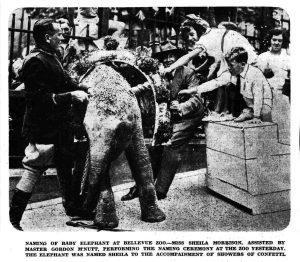
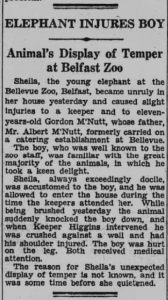 After the German air raid on the night of 15th/16th April 1941, Antrim Road residents raised concerns that dangerous animals might escape during air raids. The account in Scott Edgar’s
After the German air raid on the night of 15th/16th April 1941, Antrim Road residents raised concerns that dangerous animals might escape during air raids. The account in Scott Edgar’s 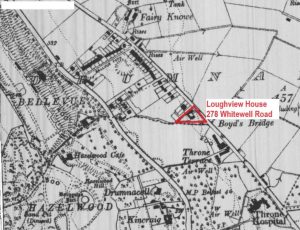
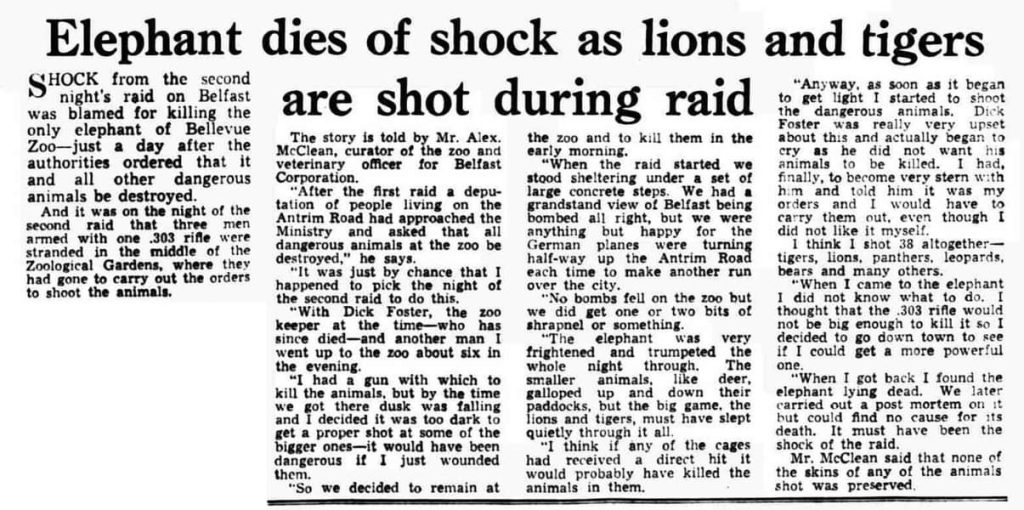
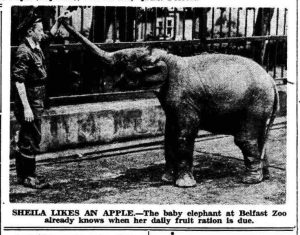
 In essence, when articles were compiled this century, the researchers knew there was an elephant called Sheila at the zoo in 1938 and that an elephant called Sheila died at the zoo in 1965. Unfortunately, they made the assumption that the elephant that died in 1965 was the elephant who had arrived in 1938.
In essence, when articles were compiled this century, the researchers knew there was an elephant called Sheila at the zoo in 1938 and that an elephant called Sheila died at the zoo in 1965. Unfortunately, they made the assumption that the elephant that died in 1965 was the elephant who had arrived in 1938.

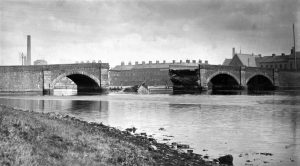

 The
The 

 The
The 
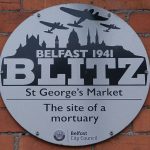 The Commonwealth War Graves Commission (CWGC) website includes a Civilian War Dead section which lists the place of death and the place of residence for fatalities, the information having been collated from the Civil Defence Authority fatality lists and other sources. The anomalies between the figures specified on the Belfast City Council plaques and the CWGC Civilian War Dead List (henceforth CWGC List) will be examined in this article.
The Commonwealth War Graves Commission (CWGC) website includes a Civilian War Dead section which lists the place of death and the place of residence for fatalities, the information having been collated from the Civil Defence Authority fatality lists and other sources. The anomalies between the figures specified on the Belfast City Council plaques and the CWGC Civilian War Dead List (henceforth CWGC List) will be examined in this article.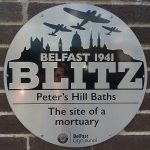 1 Temporary Mortuaries
1 Temporary Mortuaries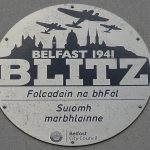
 Campbell College was taken over by the military authorities as the 24th (London) General Hospital shortly after the start of the Second World War and was hit on the night of 4th/5th May 1941. The Blitz Victims List compiled by the Northern Ireland War Memorial records that 24 people died at the hospital, including one civilian fatality. Of the 23 army personnel killed, nine are buried in Northern Ireland and the remainder were repatriated to Great Britain for interment. The civilian was Mary Jane Close (58) who was injured at her home in Westbourne Street and died at the hospital and is buried in Dundonald Cemetery.
Campbell College was taken over by the military authorities as the 24th (London) General Hospital shortly after the start of the Second World War and was hit on the night of 4th/5th May 1941. The Blitz Victims List compiled by the Northern Ireland War Memorial records that 24 people died at the hospital, including one civilian fatality. Of the 23 army personnel killed, nine are buried in Northern Ireland and the remainder were repatriated to Great Britain for interment. The civilian was Mary Jane Close (58) who was injured at her home in Westbourne Street and died at the hospital and is buried in Dundonald Cemetery.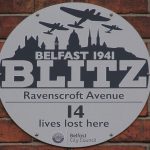
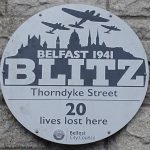 4 Mountpottinger – Thorndyke Street
4 Mountpottinger – Thorndyke Street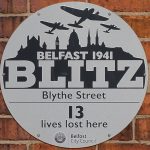 5 Sandy Row – Blythe Street
5 Sandy Row – Blythe Street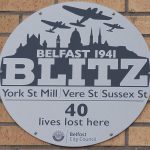
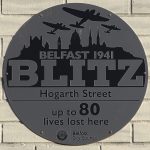 7 Tiger’s Bay – Hogarth Street
7 Tiger’s Bay – Hogarth Street
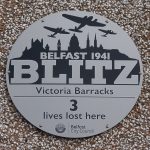
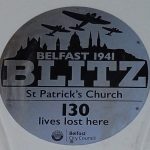 10 Donegall Street – St Patrick’s Church
10 Donegall Street – St Patrick’s Church 11 Carrick Hill – Unity Street and Trinity Street
11 Carrick Hill – Unity Street and Trinity Street
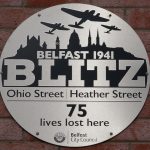
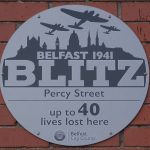
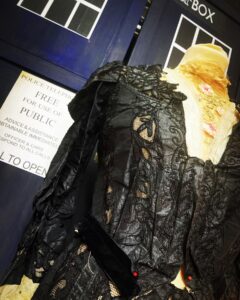
 “I wonder can anyone help me with some research pointers for this dress – it carries the label James Lindsay &Co Ulster Arcade which I believe is the Lindsay Brothers – Thomas Lindsay, Mayor of Belfast in 1875? I know they were textile merchants (and very successful too) but I don’t know if they actually produced/commissioned clothing? Any info about the company very welcome”.
“I wonder can anyone help me with some research pointers for this dress – it carries the label James Lindsay &Co Ulster Arcade which I believe is the Lindsay Brothers – Thomas Lindsay, Mayor of Belfast in 1875? I know they were textile merchants (and very successful too) but I don’t know if they actually produced/commissioned clothing? Any info about the company very welcome”. James Lindsay and Co was established at 18 Donegall Place, Belfast c 1860. The Lindsay family first came to Ireland from Scotland in 1678, with their descendants moving to Belfast in 1822, opening a “woollen, linen and haberdashery warehouse” trading as J & D Lindsay on Bridge Street. The business prospered and John and David Lindsay brought into the partnership their three younger brothers, one of whom was James Lindsay after which the business at 18 Donegall Place was named.
James Lindsay and Co was established at 18 Donegall Place, Belfast c 1860. The Lindsay family first came to Ireland from Scotland in 1678, with their descendants moving to Belfast in 1822, opening a “woollen, linen and haberdashery warehouse” trading as J & D Lindsay on Bridge Street. The business prospered and John and David Lindsay brought into the partnership their three younger brothers, one of whom was James Lindsay after which the business at 18 Donegall Place was named.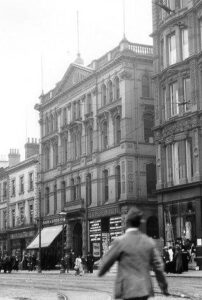 James Lindsay & Co was part of a much larger family business which traded under the name Lindsay Brothers. They first began manufacturing muslin in the early 1800s, but expanded the business to include the spinning of flax at two large mills (the Mulhouse Works and Prospect mills) and all associated processes involved in the rapidly developing linen industry. These goods were exported all over the world from their warehouse at 7-9 Donegall Place (see pic). This building still stands as the Disney Store today.
James Lindsay & Co was part of a much larger family business which traded under the name Lindsay Brothers. They first began manufacturing muslin in the early 1800s, but expanded the business to include the spinning of flax at two large mills (the Mulhouse Works and Prospect mills) and all associated processes involved in the rapidly developing linen industry. These goods were exported all over the world from their warehouse at 7-9 Donegall Place (see pic). This building still stands as the Disney Store today.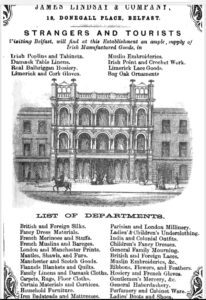 The business continued to prosper for the next 80 years, and allowed James to reside at a large house and estate called “Wheatfield” at Ballysillan, North Belfast. The business concentrated on products of Irish Manufacture, and they were soon joined by other worldwide concerns such as Robinson & Cleaver which opened their Royal Irish Linen Warehouse two doors up on Donegall Place in 1888 – the year Queen Victoria granted Belfast it’s charter as a city.
The business continued to prosper for the next 80 years, and allowed James to reside at a large house and estate called “Wheatfield” at Ballysillan, North Belfast. The business concentrated on products of Irish Manufacture, and they were soon joined by other worldwide concerns such as Robinson & Cleaver which opened their Royal Irish Linen Warehouse two doors up on Donegall Place in 1888 – the year Queen Victoria granted Belfast it’s charter as a city. 
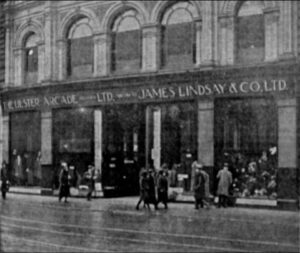
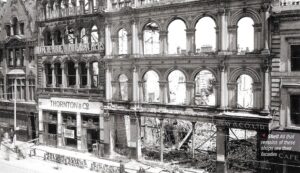
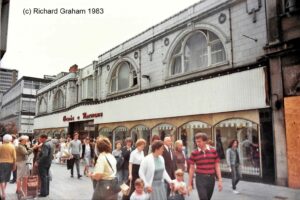 When the building was destroyed, Thomas Brand merged with Norman & Co on Castle Lane to form Brands & Normans. The Brand family also developed Brands Arcade (aka Birdcage Walk) becoming one of the most important fashion houses and retailers in Belfast in the “Swinging Sixties” Sadly that business has now also disappeared from the streets of Belfast, as has C&A, Robinson & Cleaver, Anderson & McAuley and all the other great stores, even up to last month when Debenhams closed down.
When the building was destroyed, Thomas Brand merged with Norman & Co on Castle Lane to form Brands & Normans. The Brand family also developed Brands Arcade (aka Birdcage Walk) becoming one of the most important fashion houses and retailers in Belfast in the “Swinging Sixties” Sadly that business has now also disappeared from the streets of Belfast, as has C&A, Robinson & Cleaver, Anderson & McAuley and all the other great stores, even up to last month when Debenhams closed down.


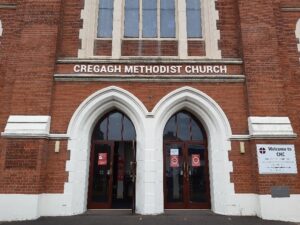

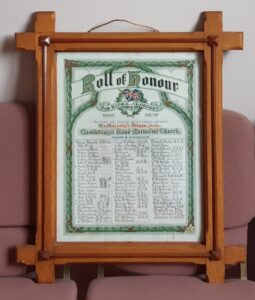
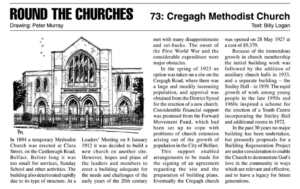
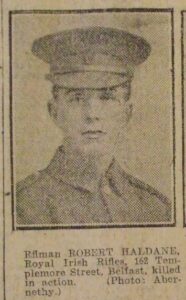

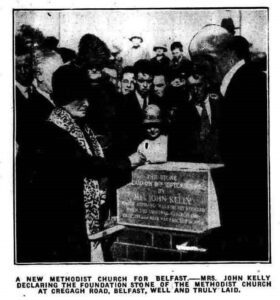
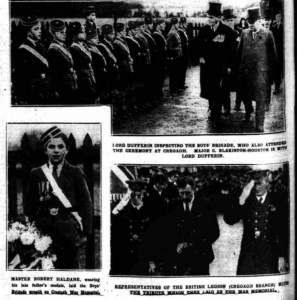

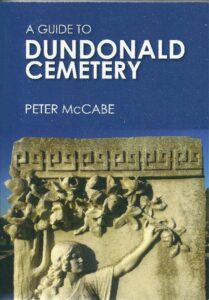
 Trail 1 is the Quirky Trail, and the headstone I’ve selected for this is William Johnston, ‘a musician, an Elvis impressionist (Billy Fonda). Bill grew up on Donegall Road, The Village, Belfast. Laid to rest 17th December 2004’, with the Quirky trail also featuring Elmekki Berrabah ‘“Kebab Man” Returned To Allah On 12th April 2015’, and he is buried in the small Muslim section of the Cemetery.
Trail 1 is the Quirky Trail, and the headstone I’ve selected for this is William Johnston, ‘a musician, an Elvis impressionist (Billy Fonda). Bill grew up on Donegall Road, The Village, Belfast. Laid to rest 17th December 2004’, with the Quirky trail also featuring Elmekki Berrabah ‘“Kebab Man” Returned To Allah On 12th April 2015’, and he is buried in the small Muslim section of the Cemetery.
